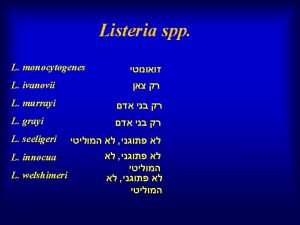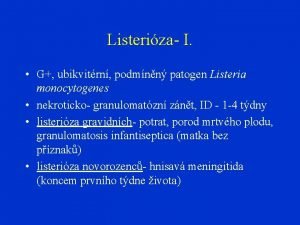Annotation of Rhodococcus erythropolis Phage Singletons Chewy VIII

- Slides: 1

Annotation of Rhodococcus erythropolis Phage Singletons Chewy. VIII and Trina Gillian Holder, Jordan Wagner, Victoria Albritton, Martiana Beach, Christian Bonner, Caleb Green, Makenzie Harrell, Alyssa Juneau, Gabrielle Labat, Shelby Lawrence, Daniel Myers, Anthony Nowell, Zachary Palowsky, Makayla Peoples, London Peterson-Gross, Shelby Rybicki, Colbren Thomas, Naadia West, Dezirea Williams, G. Brooke Morgan, Fernanda L. Alonzo, Paul D. Wiedemeier, Allison M. D. Wiedemeier, Chris R. Gissendanner, and Ann M. Findley Biology, School of Sciences and Basic Pharmaceutical Sciences, School of Pharmacy University of Louisiana at Monroe, LA 71209 Four novel Rhodococcus erythropolis phages were isolated from northeast Louisiana area soil samples. To date, Rhodoccocus phages Chewy VIII and Trina have been sequenced (Illumina Sequencing, University of Pittsburgh) and their genomes annotated with the DNA Master bioinformatics platform. Chewy VIII is a siphoviridae phage with 69, 165 bp including a 10 bp 3’ overhang, 100 open reading frames (ORFs) and no t. RNA gene coding regions. Trina is 139, 262 bp including a 2860 bp terminal repeat and has 249 ORFs and 25 t. RNA genes. While functional gene calls can be identified for both genomes, the majority of open reading frames have no sequence homology to any known gene product currently found in Gen. Bank and are consequently labeled as ‘orphams’. Phamerator comparison of a number of recently sequenced Rhodococcus phages indicates that both ULM isolates are significantly different from other existing isolates and are currently designated as ‘Singletons’. Chewy has some BLASTn hits to Gordonia phages but only ~20% query coverage. While Trina is about the same size as Rhodococcus phages Grayson and Peregrin, it is only ~10% similar at the nucleotide level. A BLASTn comparison of Trina and Chewy VIII against the Mycobacteriophage database revealed that Trina displays some limited similarity to L 1 cluster mycobacteriophages while Chewy VIII shows a higher degree of similarity to M cluster phages. STATEMENT OF PROBLEM Utilizing protocols provided found on phagesdb. org, ULM SEA PHAGES students isolated four Rhodococcus erythropolis phages – Chewy VIII, Trina, Measels, and John. Spot. Chewy VIII and Trina were sequenced and while both of these Rhodococcus phage singletons display limited sequence homology to known Actinobacteriophages, they do display multiple BLAST hits to phages that infect Rhodococcus, Gordonia, Streptomyces, and Mycobacterium hosts. As such, Chewy VIII and Trina may present good candidates for the study of lateral gene transfer among the Actinobacteriophages. PLAQUE MORPHOLOGY Trina produces small lytic plaques after 48 hr incubation. Phage isolate was purified from an enriched soil sample from Benton, LA. PHAMERATOR COMPARISON FUNCTIONAL GENE CALLS ABSTRACT Chewy. VIII produces lytic plaques with 24 hr incubation. Phage Isolate was purified from an enriched soil sample from Benton, LA. CHEWY VIII Putative Functions ORF TRINA Putative Functions Alignment/E/Query Putative Function 3 50. 2%/6. 8/24: 18 Sulfur transferase 11 74. 2%/0. 26/37: 12 AT Hook Motif 12 14. 3%/9. 05/ Carbamoyl dehydratase 14 89. 6%/7. 16/66: 13 Aldehyde activator 22 6. 2%/1. 64/19: 651 Ubiquitin thioesterase 26 98. 5%/0. 00/27: 6 Ribonucleotide diphosphate reductase - beta subunit 27 29. 1%/0. 48/9: 105 Chromodomain-helicase. DNA-binding protein ORF Alignment/E/Query Putative Function 2 3 6 7 9 10 12 16 19 20 21 22 24 26 24. 2%/0. 92/3: 64 22. 6%/2. 52/35: 132 2. 9%/4. 24/5: 1347 12. 7%/4. 83/9: 108 22%/0. 32/15: 248 9. 1%/4. 63/26: 465 15. 5%/1. 25/20: 347 19. 2%/9. 99/26: 104 28. 2%/7. 77/6: 142 4. 6%/4. 09/11: 608 96. 5%/0. 00/2: 3 22. 6%/4. 64/1: 27 37%/5. 93/7: 80 99. 8%/0. 00/3: 2 Acyltransferase Transfer protein Chemotaxis protein Secretion protein Sulfotransferase Ribonuclease R, partial DNA primase Transcription regulator 3 -oxoacyl-ACP-reductase Aminopeptidase DNA methylase Transcription regulator Purine phosphorylase Nicotinate phosphoribosyltransferase 29 30 32 33 34 37 41 42 10. 6%/0. 28/12: 404 5. 6%/8. 39/2: 404 35%/4. 2/43: 750 87. 4/1. 4 e-26 91%/6. 3/13: 216 11%/8. 21/4: 384 98. 5%/1. 0 e-29/5: 6 98. 8%/0. 00/2: 4 Nitrate reductase Carboxypeptidase Polymerase RNA methylase transferase Adenylate cyclase Helicase ADP-ribosyllation protein FAD-dependent thymidylate synthase 30 15. 6%/2. 21/6: 173 CHRD domain-containing protein 36 95. 5%/0. 00/1: 1 (FAD dependent) Thymidylate synthase 39 30. 9%/3 e-20/64: 76 Collagen triple helix family protein 44 49. 5%/8. 2 e-28/33: 47 Resucritation-promoting factor 47 55 58 76. 8%/5. 3 e-30/28: 68 100%/0. 00/1: 1 97. 2%/0. 00/5: 6 Methyltransferase Glycosyl-transferase Ribonucleosidediphosphate reductase, alpha subunit 65 67 69 70 77 78 81 82 84 88 92 45. 7%/0. 31/43: 85 91. 3%/1. 2 e-41/46: 29 98. 1%/0. 00/7: 2 99. 1%/0. 00/3: 2 41. 1%/1. 15/10: 80 17. 7%/0. 17/16: 58 49. 7%/2. 8 e-39/246: 52 79. 5%/0. 08/1: 25 40. 1%/0. 00/3: 2 99. 6%/0. 00/3: 2 14%/8. 58/29: 41 l-asparaginase Portal protein Maturation protease Major capsid protein Kinase Transposase Minor tail protein 50 s ribosomal protein Minor tail protein Metallophosphoesterase Intermediate filament tail protein 95 97 99 100 101 97%/0. 00/27: 4 92. 1%/8. 3 e-40/2: 17 27%/0. 00/5: 6 42. 4%/0. 00/10: 301 22. 7%/0. 85/11: 139 DNA helicase DNA primase DNA polymerase III Hydrogenase nickel incorporation protein 103 115 99. 4%/0. 00/1: 1 91. 5%/6. 6 e-31/6: 8 Rec-A-like Recombinase Terminase association HNH endonuclease 135 151 57%/4 e-67/5: 7 31. 9%/6. 03/3: 82 Actinase Uroporphyrin-III methyltransferase 180 181 188 194 37. 3%/1. 77/12: 18 21. 4%/4. 50/7: 260 31. 5%/0. 06/12: 110 18. 2%/2. 09/28: 269 Epimerase 3 -dehydroquinate synthase Nuclease DNA polymerase III beta subunit 204 5%/1. 47/16: 307 Putative alpha-glycanwater dikinase 207 16. 2%/7. 60/38: 69 Iron ABC transporter permease 216 227 229 89. 3%/4 e-25/4: 8 18. 6%/1. 60/3: 110 20. 4%/10. 0/21: 3 Response regulator protein DNA binding protein Ribose ABC transporter auxiliary component 233 234 6. 9%/5. 68/2: 158 9. 9%/1. 99/22: 15 Alpha-glucosidase Adenosylmethionine-8 amino-7 -oxonoanoate aminotransferase 236 16%/0. 085/6: 246 Histinidol-phosphate aminotransferase 237 240 55%/2. 67/11: 45 34%/0. 65/11: 19 ABC-2 -transporter RNA/thiamine triphosphate 245 27%/8. 02/7: 167 ABC transporter sunstratebinding protein 247 24. 4%/0. 47/3: 63 Phospholipid/glycerolacyltr ansferase 249 25. 7%/1. 20/110: 291 Translocation Tol. B protein 43 96. 3%/0. 00/1: 21 Terminase 61 97. 6%/0. 00/7: 10 Tail protein 62 98. 3%/3. 3 e-24/8: 7 Tail protein 64 68. 6%/0. 64/13: 4 Sporulation protein 75 70. 2%/0. 00/3: 34 DNA polymerase - alpha subunit 80 91. 8%/0. 00/5: 25 DNA methylase 82 50. 5%/0. 37/60: 36 Translocase 83 65. 7%/4 e-21/5: 7 AAA-ATPase 85 93. 8%/0. 00/12: 16 PAPS reductase 89 86. 1/0. 00/127: 101 Helicase 96 81%/8. 83/53: 663 ATP-dependent exonuclease 97 12. 4%/3. 30/17: 252 l-asparaginase 99 20. 1%/9. 3/6: 142 Cobalt ABC transporter ATPbinding protein Trina t. RNA Number 1 Amino acid charge Glycine 2 Glutamate 3 Asparagine 4 Lysine 5 Lysine 6 Lysine 7 Arginine 8 Glutamine 9 Histidine 10 Serine 11 Threonine 12 Threonine 13 Glycine 14 Tryptophan 15 Cysteine 16 Isoleucine 17 Valine 18 Alanine 19 Asparagine 20 Proline 21 Phenylalanine 22 Leucine 23 Leucine 24 Leucine 25 Isoleucine Analysis of Chewy. VIII genome compared to Rhodococcus phages Reqi. Pine 5 and E 3. Analysis of Trina genome compared to Rhodococcus phages Peregrin and Grayson. BLASTn SEQUENCE COMPARISON PHAGE ENZYME TOOL OUTPUT - http: //phageenzymetools. com EM PROFILES Explanation Trina Chewy VIII Explanation Acknowledgments: This work was supported by the HHMI – SEA – Phage Hunters Program and Louisiana INBRE program. BLASTn results for Chewy VIII show limited sequence homology with Gordonia, Rhodococcus, Streptomyces, and Mycobacterium phages. BLASTn results for Trina show limited sequence homology with Rhodococcus, Streptomyces, Gordonia, and Mycobacterium phages.

